This spicy creamy crab onigiri is small in size but packed with big flavors. The filling requires only 5 ingredients, plus salt and pepper! It’s light, bright, zesty, creamy, spicy – I mean I could probably go on and on!
To save time, I used my trusty onigiri mold but you can also use your hands for shaping. Follow my instructions below for hand-shaped onigiri!
I like to serve my spicy crab onigiri with a can of soda or an ice-cold glass of my homemade matcha latte.
Why you’ll love this recipe
Onigiris are Japanese rice balls usually made with raw or cooked fillings like crab, tuna, or salmon. It’s wrapped with a crisp sheet of roasted seaweed for umami and extra flavor, which also serves as the handle.
First, they are very versatile. I like to fill my onigiri with various ingredients including recipes like:
You can even fill them with leftovers like roasted chicken to make an extra meal out of it.
Onigiris are also fun to make, whether you’re by yourself or with a group of people! It usually takes around 15 minutes or so to make these. Onigiri making would be a great activity for parents and their little foodie kids! Because of their size and presentation, onigiris are also very easy to carry and eat on the go, making them the perfect snack or lunch meal for busy students and adults! These can also be made 2 days in advance and stored in the fridge.
Crab Onigiri Ingredients and Substitutions
Cooked rice: The best kind of rice to use would be short-grain rice, also known as sushi rice because it is the stickiest out of all the rice varieties. The stickier the rice, the easier it will be to shape the onigiris. As a substitute, you can use medium-grain rice, which is what I usually use. I don’t recommend using any type of long-grain rice, like Jasmine or Basmati, because they have really low starch content. It’ll be quite difficult to shape the onigiris if using this type of rice.
Furikake seasoning: This is an umami-rich seasoning that makes the rice even more delicious! Furikake is basically a mix of nori, sesame seeds, fish or bonito flakes, and other flavoring ingredients. There are different variants, feel free to use what you like the most. I used the Bonito and Egg variety.
Roasted seaweed sheets: An onigiri is incomplete without a sheet of roasted seaweed. It adds a nice presentation and also serves as the handle of the onigiri.
Spicy Creamy Crab Filling Ingredients and Substitutions
Imitation crab sticks: Also referred to as kanikama or kani, crab sticks are not actually made of crab. They’re usually made of white fish and crab which is then combined with starch and made to look like crab legs. This can be substituted with real fresh crab or canned crab meat. But for convenience, I like using kani. These can usually be found in the freezer section of your local Asian market.
Kewpie mayo: Kewpie Japanese mayo is richer than other types of mayo because it is made of purely egg yolks and not whole eggs. This can be substituted with regular mayo, but I highly recommend using Kewpie mayo if you can!
Sambal: An Asian chili paste, that is super delicious! Just a little goes a long way so make sure to taste the crab mixture before adding more. Sambal can be substituted with sriracha.

Lemon zest: For added freshness and a bright taste.
Scallions: Adds freshness and a sharp oniony flavor, but not as strong and overpowering as onions. This can be substituted with chives.
Salt: Since different brands of imitation crab meat have different levels of saltiness, be sure to taste the filling first then adjust the seasoning accordingly.
Ground black pepper: For seasoning and a peppery spice.
How to make Spicy Creamy Crab Onigiri
Step 1: Prepare the rice
Place the cooked rice in a large mixing bowl and allow to cool to room temperature. Mix in furikake seasoning until well combined. Set aside.


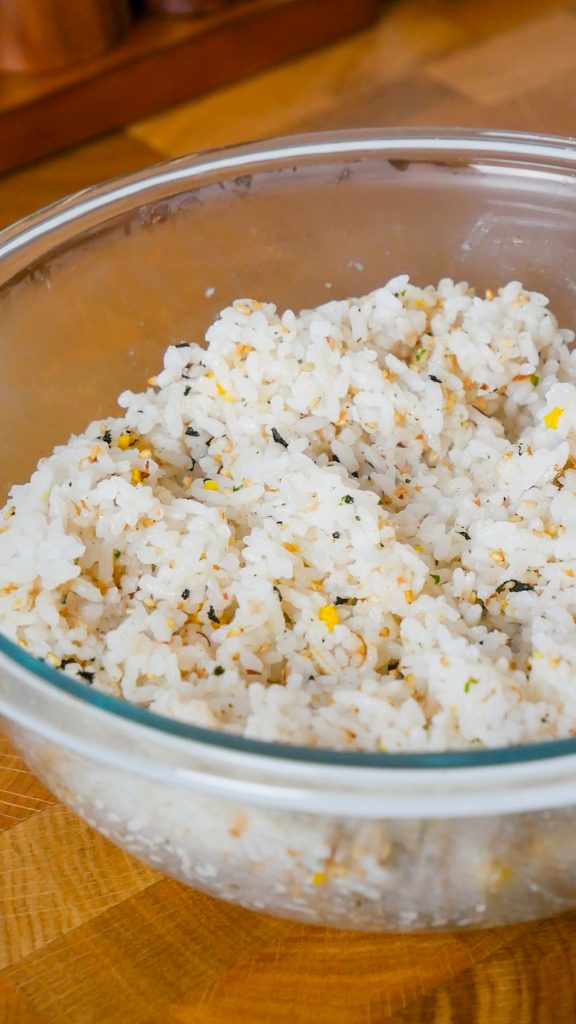
Step 2: Make the crab filling
In a small mixing bowl, shred the imitation crab sticks. Then add Kewpie Japanese mayo, sambal, lemon zest, scallions, salt, and ground black pepper. Mix well until combined.
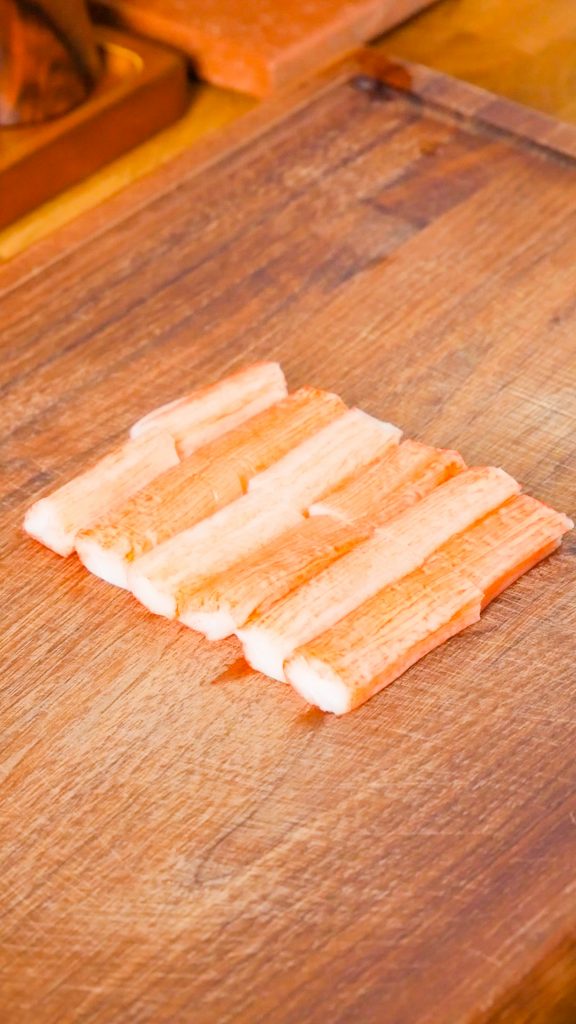


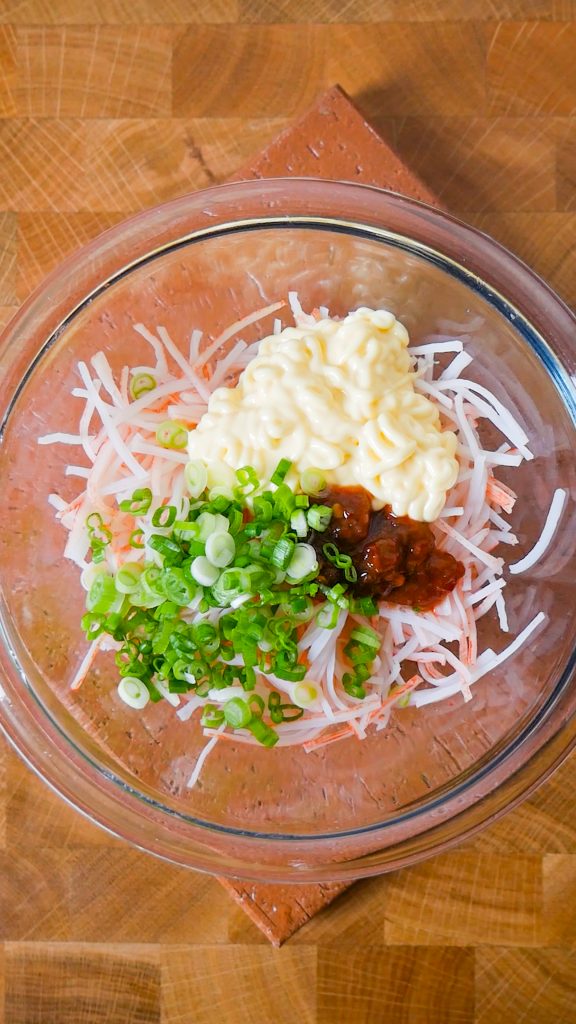
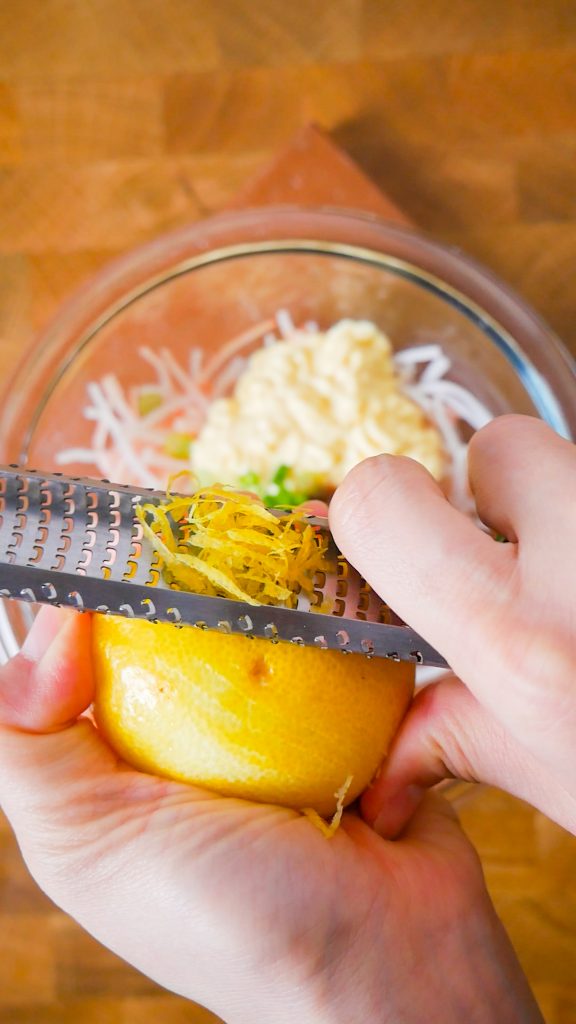


Step 3: Assemble the onigiri
Now let’s shape the onigiri! If using a mold, follow the instructions according to the package.
If shaping by hand, wet both hands and using two fingers, dip it in the bowl with salt. Rub the salt into the palm of your hands until evenly coated. Grab about 1/4 cup rice and flatten it out on the palm of your hand. Add the filling by placing 1 to 2 tablespoons of the crab mixture in the center. Top with some more rice and press it down so the rice on top sticks to the rice on the bottom. Using your palms, apply pressure and shape the onigiri into a triangle. To create a triangle shape, make the palm of one hand flat and make a 90-degree angle with the other hand. Shape the rice ball using this formation while rotating. Be sure to apply pressure when shaping! This may take some practice and a few tries.
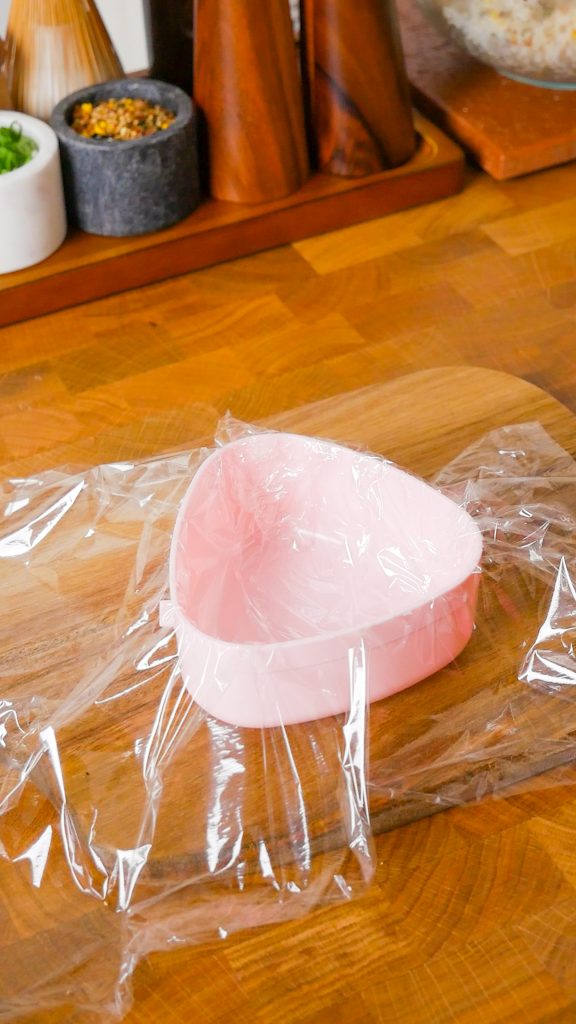
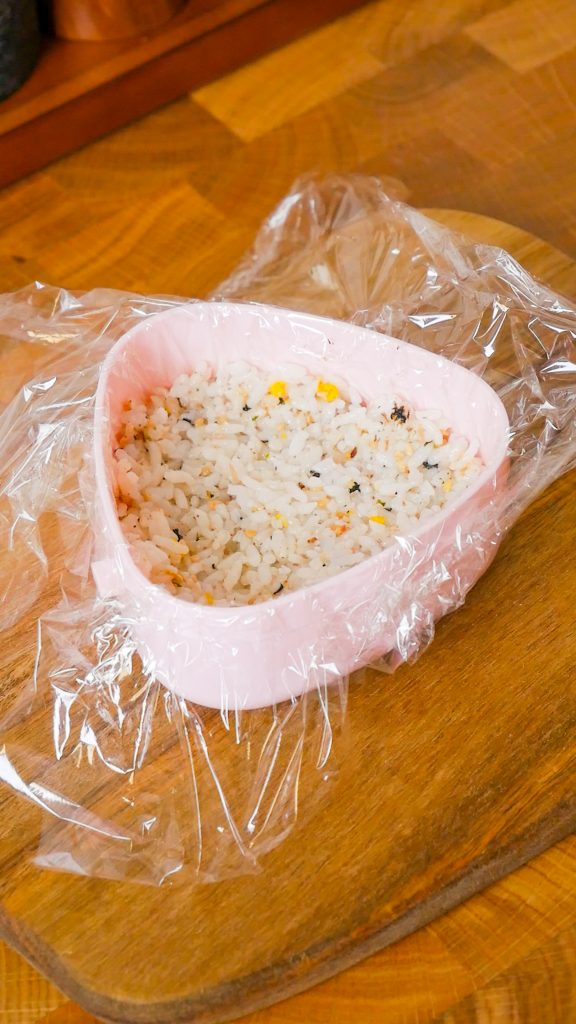

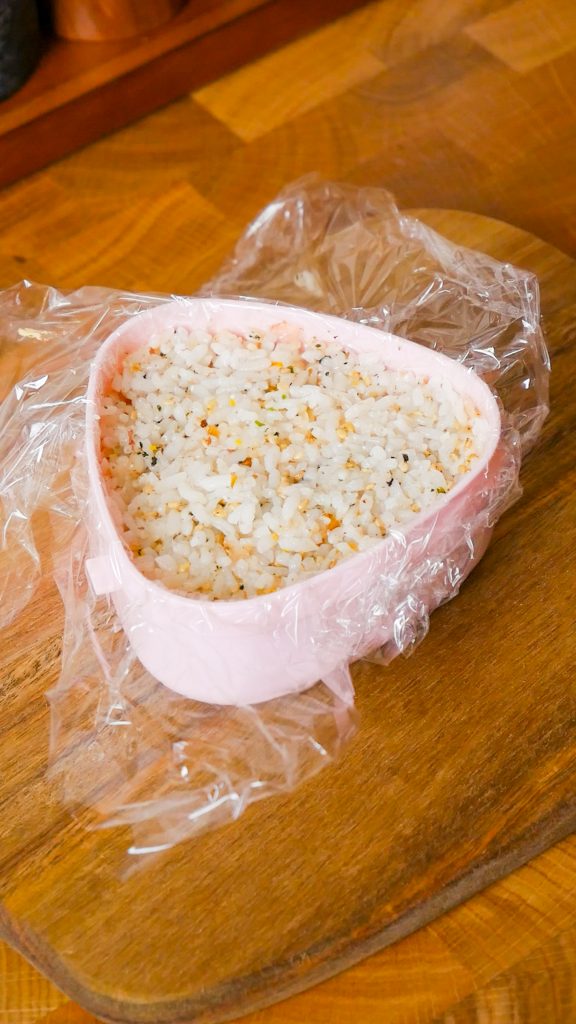


Step 4: Garnish & serve
Wrap the onigiri with a nori sheet and enjoy!
*Optional* Garnish the top of the onigiri with Kewpie mayo, scallions, and a piece of imitation crab.


Preparation Tips for Spicy Creamy Crab Onigiri
- Use the right kind of rice. Sushi rice (also known as short-grain rice) or medium-grain rice works best due to its high starch content. They’re starchy and turn out sticky, which allows the onigiris to hold their shape. I do not recommend using long-grain rice as it has a low starch content and won’t hold shape.
- Customize the filling by adding or substituting ingredients you enjoy, including sesame seeds, sesame oil, sriracha, or soy sauce for added umami.
- Fill the rice balls with just enough filling. You don’t want to overstuff them otherwise, they will fall apart. Pack them firmly by pressing the rice together gently. You want to ensure that there is no hollow space between the rice grains and the filling.
- If molding the onigiri using your hands, wet your hands with water before touching the rice to prevent it from sticking. It would be great to have a bowl of rice on the side as you hand-roll onigiris.
- Onigiris can be made two days in advance and stored in the fridge. After assembling, wrap each onigiri in plastic wrap. Right before serving, wrap a roasted seaweed sheet and enjoy!

Frequently Asked Questions
How do you keep onigiri from falling apart?
To keep the onigiris from falling apart, it is important to pack them tightly and mold them firmly. Do this by applying gentle yet even pressure on the molder or using your hands, sealing all pockets of air out of the onigiri. You will feel it when the rice balls are already firmly packed.
In addition, it’s best to wrap them in plastic wrap to seal them fresh, prevent them from drying out, and help keep them in shape.
What kind of rice is used in onigiri?
Onigiri uses sushi rice (also known as short-grain) or medium-grain rice. These types of rice are starchy and therefore when cooked, result in rice that’s quite sticky. Long-grain rice is not ideal as it is fluffy and won’t hold shape.
Should I let rice cool before making onigiri?
Yes! To prevent yourself from getting burned, let the rice cool before shaping onigiri. It’ll just be easier to handle.
Can I keep onigiri overnight?
Yes. You can keep onigiri for up to two days in the fridge. To store, individually wrap them in plastic wrap and then place them in air-tight containers in the fridge. Be sure not to wrap them with seaweed ahead of time otherwise, it will lose its crispness. The seaweed should be stored separately at room temperature and wrapped right before serving.
Can you use regular rice for onigiri?
‘Regular rice’ can be a number of different things so it really depends on the kind of rice. The rice grains need to stick together in order to hold their shape. So if your regular rice is on the starchy and sticky side, like short-grain or medium-grain rice, you can definitely use them to make onigiri!
Can you make onigiri with refrigerated rice?
Freshly cooked rice is ideal but refrigerated rice would work too. If you do have leftover cold short-grain or medium-grain rice in the fridge, you will need to reheat it before using it. Simply microwave it until thoroughly warmed then allow it to come to room temperature before assembling.
Is it safe to reheat onigiri?
Onigiris can be enjoyed cold. In Japan, onigiris are available in the refrigerated section of convenience stores like 7-Eleven and they taste just as delicious! I don’t recommend reheating onigiri for the simple fact that the seaweed will get soggy and the onigiri may fall apart. But if you really wanted to, you could reheat them for a minute in the microwave.
Looking for more easy and delicious Japanese-inspired rice recipes?
Ikura Don — Freshly cooked white rice is topped with soy-marinated ikura, or raw salmon roe, and egg. Each spoonful is an explosion of fresh, savory, and umami goodness!
Spicy Tuna Salad with Crispy Rice — If you’ve ever craved the viral spicy tuna crispy rice but don’t want the sushi-grade or restaurant price tag that it comes with, this dupe is for you! Crispy fried rice is topped with avocado and a spicy tuna salad mixture.
Easy Chicken Katsu — If you’re a fried chicken lover or a fan of Japanese cuisine, this crispy and juicy chicken katsu recipe will surely satisfy you! The combination of the beautiful golden brown exterior coupled with the tender and juicy interior makes this incredibly irresistible. You can serve it with a simple bowl of rice, on top of a plate of curry, or with a cold and refreshing salad.
Kimchi Egg & Spam Onigarazu — A variation of onigiri, imagine a sandwich but instead of using bread, roasted seaweed is filled with rice and various fillings. For this recipe, I used a combination of all my favorite ingredients which include spam, kimchi, avocado, and a beautifully cooked egg!
Oyakodon Japanese Chicken & Egg Rice Bowl — Oyakodon is a rice bowl topped with chicken and egg with a savory soy and dashi broth. It’s comforting, delicious, and packed with so much flavor.
Japanese Beef Rice Bowl — Japanese-style beef rice bowl or ‘gyudon‘ is a quick, hearty, and satisfying meal that comes together in just 15 minutes. It’s a simple yet satisfying dish that is made of thinly sliced beef and aromatics cooked in a sweet and savory sauce and served over a bowl of steaming rice.

Spicy Creamy Crab Onigiri Recipe
Ingredients
- 3 cups cooked rice short-grain or medium-grain rice
- 3 tbsp furikake seasoning Japanese rice seasoning
- roasted seaweed sheets non-salted
Spicy Creamy Crab Filling
- 6 imitation crab sticks
- 2-3 tbsp Japanese Kewpie mayo substitute with regular mayo
- 1 1/2 tsp sambal (chili paste) substitute with Sriracha
- 1/2 tsp lemon zest
- 1 scallion chopped
- 1/8 tsp salt adjust to taste
- 1/8 tsp ground black pepper
Instructions
- Place the cooked rice in a large mixing bowl and allow to cool to room temperature. Mix in furikake seasoning until well combined. Set aside.
- In a small mixing bowl, shred the imitation crab sticks. Then add Kewpie mayo, sambal, lemon zest, scallions, salt, and ground black pepper. Mix well until combined.
- Now let's shape the onigiri! If using a mold, follow the instructions according to the package. If shaping by hand, wet both hands and using two fingers, dip it in the bowl with salt. Rub the salt into the palm of your hands until evenly coated. Grab about 1/4 cup rice and flatten it out on the palm of your hand. Place 1 to 2 tablespoons of the crab-filling mixture in the center. Top with some more rice and press it down so the rice on top sticks to the rice on the bottom. Using your palms, apply pressure and shape the onigiri into a triangle. To create a triangle shape, make the palm of one hand flat and make a 90-degree angle with the other hand. Shape the rice ball using this formation while rotating. Be sure to apply pressure when shaping! This may take some practice and a few tries.
- Wrap the onigiri with a nori sheet and enjoy!
- *Optional* Garnish the top of the onigiri with Kewpie mayo, scallions, and a piece of imitation crab.
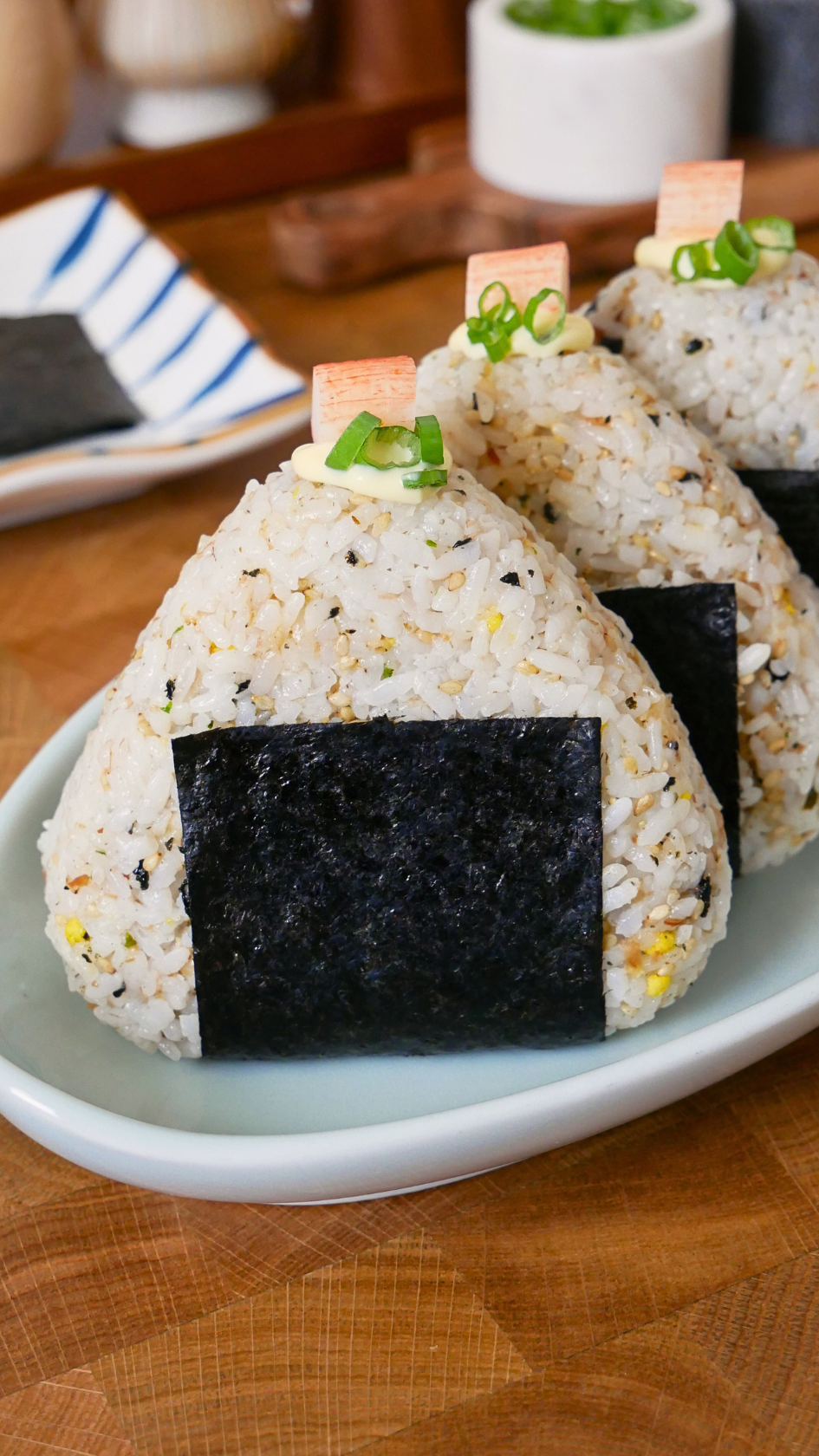
These are amazing and exactly what I was hoping for. I used short grain rice and gochujang for the chili paste (just what I had on hand). The recipe has the perfect blend of sweet, spicy, and umami as well as a good ratio of rice to nori to filling. The furikake with sesame seeds also makes for a fun texture with the rice. Highly recommend!
Hi Sammie! I’m so happy to hear you enjoyed this recipe! It’s so simple but so delicious at the same time. Also love the use of gochujang – I think I’ll have to try it next time 🙂
Great recipe! I used this in a cooking comp and it was amazing.
Hi Maddy, I’m super happy to hear this turned out amazing! I hope you won the cooking comp with this one!! 🙂